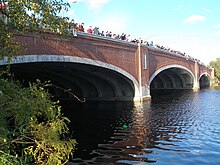Charles River Reservation
| Charles River Basin Historic District | ||
|---|---|---|
| National Register of Historic Places | ||
| Historic District | ||
|
On the banks of the Charles River in the sanctuary |
||
|
|
||
| location | Boston , Cambridge , Watertown and Newton , Massachusetts , United States | |
| Coordinates | 42 ° 21 '46 " N , 71 ° 6' 28" W | |
| surface | 820 acres (3.3 km²) | |
| Built | 1893 | |
| Architectural style | Colonial Revival , Classicism , Modernism | |
| NRHP number | [1] 78000436 | |
| The NRHP added | December 22, 1978 | |
The area Charles River Reservation is a 17 mi (27,36 km ) long state park in the state of Massachusetts of the United States . The park is administered by the Department of Conservation and Recreation and is part of the Metropolitan Park System of Greater Boston . Its area runs along the Charles River and includes parts of the metropolitan areas of Boston , Cambridge , Watertown, and Newton . The portion of the park between the Charles River Dam and Eliot Bridge is listed as a National Historic District on the National Register of Historic Places . The areas above the dam are administered as the Upper Charles River Reservation .
Components of the protected area
The Charles River Dam
The Charles River Dam , built in 1978 behind the TD Garden , enables the water level in the river bed to be controlled. As early as 1910, a first dam was built below the Museum of Science to create a drinking water lake with an attached park in the city. The redesigned banks of the river became known as the Charles River Esplanade . In today's dam there are six pumps for effective flood protection. The lock system of the dam connects the river with the port and is in operation all year round. There is also a fish ladder that allows the migratory fish allis shad , rainbow smelt and alosa to climb up during their migration in late spring.
The Charles River Basin and the Charles River Esplanade
The Charles River Basin was created in the early 20th century on salt marshes and mud flats with the aim of giving the population access to an outstanding river landscape with recreational opportunities both on water and on land. Although the river basin was created artificially, it is now an important habitat for hundreds of wild animals and plant species, which on the one hand play an important role for the ecology in the region and on the other hand delight park visitors. The water quality of the once heavily polluted basin has improved greatly in recent years and now attracts both wild animals and people to the river.
The character of the river basin changes several times along this 8.5 mi (13.68 km ) long section and forms three recognizable zones: The Lower Basin extends from the historic Charles River Dam to the Boston University Bridge , the Middle Basin is the section of the bridge to Herter Park , and the Upper Basin leads from there to Watertown Dam .
The Lower Basin is 2.5 mi (4.02 km ) long and 2,000 ft (609.6 m ) wide. Dominating at this point are the Longfellow Bridge , the climb to Beacon Hill and the golden dome of the Massachusetts State House . In particular, the parking areas within the protected area, such as Magazine Beach and Herter Park , offer open spaces that are used intensively by residents of the surrounding districts.
In the Middle Basin , a change is taking place from the previous urban and formal to a rural and natural environment. The parkways along the course of the river separate it from the adjacent areas. The largest open space is located between the sports facilities of Harvard University on the south shore and the cemeteries Mount Auburn Cemetery and Cambridge to the north. Together these areas form a vital oasis for migratory birds .
The John F. Kennedy Park

This 5 acres (2 hectare ) park is located approximately 500 m southwest of Harvard Square and directly north of the Anderson Memorial Bridge in the city of Cambridge and was named after the former President of the United States of the same name . Plants that bloom around John F. Kennedy's birthday in May have been incorporated into the design of the park , and there is a memorial fountain . The materials and plants used in the park - like some native trees and the granite from which the fountain was made - come from New England . The fountain and the pillars at the entrance bear inscriptions with quotations from the speeches of the former president.
The Riverbend Park
The Riverbend Park extends on the north side of the Charles River from the Eliot Bridge to Western Avenue in Cambridge . Memorial Drive is closed to through traffic on Sundays during the warmer months .
Recreational and leisure activities
Through the reserve runs Radwanderweg Charles River Bike Path . Boat tours are offered on the river, and canoeing , sailing and rowing are also possible. There are some picnic , sports and playgrounds , and ice skating is possible in winter . Every now and then there are concerts .
Individual evidence
- ^ National Register Information System . In: National Register of Historic Places . National Park Service . Retrieved March 13, 2009.
- ^ Charles River Reservation - Recreation . Mass.gov. Archived from the original on March 10, 2013. Info: The archive link was inserted automatically and has not yet been checked. Please check the original and archive link according to the instructions and then remove this notice. Retrieved August 31, 2011.
literature
- Karl Haglund: Inventing the Charles River . MIT Press, Cambridge 2003, ISBN 978-0-262-27469-2 .

